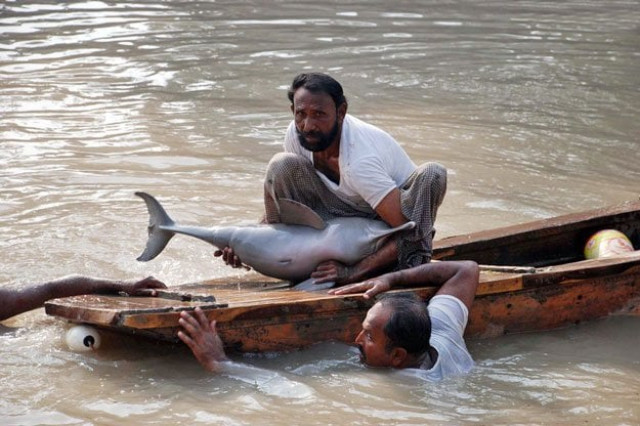‘Development along Indus imperils blind dolphins’
80 per cent decline observed in species range of cetaceans, says expert

Development initiatives along the Indus River pose a threat to the safety of prey species, particularly blind dolphins, World Wide Fund for Nature-Pakistan (WWF-P) officials have raised alarm.
In a statement issued in relevance to World River Dolphin Day on Saturday, they maintained that dams altered river ecology and sediment flow, which in turn affected the hydrology and flows of a river.
This poses a threat to prey species and their breeding grounds and among them, notably to blind dolphins and their natural habitat, they pointed out.
Moreover, the inland waterway project planned to develop the Indus River for transporting goods through vessels could also be detrimental for the Indus’ dolphin population, they added.
WWF-P’s River Dolphin Rivers Initiative coordinator in Asia Dr Uzma Khan recalled that blind Indus dolphins were once found in all major rivers of Pakistan, including Sutlej, Ravi and Jhelum. However, infrastructural development wiped out the population in those rivers and now they are only found in the Indus River, she said.
Dr Khan stated that a decline of around 80 per cent had been witnessed in the species range of blind Indus dolphins due to the construction of barrages.
She further said that canal stranding was a regular occurrence and on average, eight dolphins were trapped in water channels annually. They then have to be physically shifted back to the mainstream of the Indus River, explained Dr Khan.
“Apart from habitat fragmentation, unsustainable and illegal fishing practices [also] pose a threat to the population of the blind Indus dolphin,” she added.
Tagging
As per the statement, to monitor the migration movement and behaviour of the freshwater species, WWF-P, in collaboration with the Sindh Wildlife Department and Punjab Wildlife and Parks Department, plans to tag three dolphins soon.
The blind Indus dolphin was tagged in 2009 and the move provided key insights about the species, besides demonstrated that dolphins could move upstream and downstream in the Sukkur barrage.
Tagging more dolphins will help generate information about the impact of seasonal variations and changes in freshwater flows and the quality of water, according to the WWF-P.
The WWF-P notes that Pakistan presents a unique tagging opportunity as dolphins here are regularly rescued from canals after they are starnded.
According to the last survey conducted in 2017, a total of 1,816 dolphins were reported to be present in the Indus River, with the largest population, comprising 1,075 individuals, living in a 200-kilometre-long patch between the Guddu barrage and Sukkur barrage- together declared as the Indus Dolphin Reserve in 1974.
Earlier, three surveys were conducted in 2001, 2006 and 2011, where 965, 1,410 and 1,452 dolphins were found to be alive, respectively.
WWF-P stated that due to the involvement of local communities in dolphin conservation initiatives, partnerships and awareness campaigns, the number of dolphins had almost doubled in the last two decades.
The international foundation working for the conservation of animals believes that entanglement in fishing nets, shortage of fresh water, construction of canals and barrages on the Indus River and water pollution are key threats to the already endangered blind Indus dolphins.
However, community awareness and participation in rescue operations, engagement of academia and research institutes and other relevant stakeholders could play a pivotal role in the conservation of the freshwater cetacean.
Published in The Express Tribune, October 25th, 2020.



















COMMENTS
Comments are moderated and generally will be posted if they are on-topic and not abusive.
For more information, please see our Comments FAQ